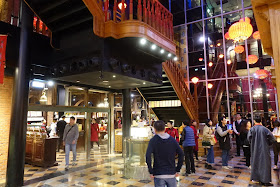To an certain extent, the town of Taichung does remind me of Bilbao, which was hardly surprising since at some point that’s what they have aspired to be, trying to turn this old industrial town into some kind of cultural and art center of Taiwan, just like what the industrial Basque town of Bilbao did in the late 1980s and 90s. They even tried to replicate Bilbao’s successful Guggenheim project by proposing a branch for this famous modern art museum in the city some time back (which never materialized at the end due to lack of government funding)
Other than the fact that they were very reasonably priced and conveniently located, one major reason for me choosing to stay here is the little stand-up restaurant on the ground floor called Bashi Bao (盛橋刈包). They were famous for their gua bao (刈包), the Taiwanese steamed buns, and they serve a special edition breakfast gua bao exclusively to the guests staying at the hotel. During my stay there, I did try both their regular gua bao and the breakfast one, and they were excellent. The buns were soft and warm, cooked fresh from the wooden steamer, with a choice of 3 fillings, topped with the signature Taichung Dongchuan (東泉) chili sauce. (and for breakfast it’s cheese, ground pork and lettuce) They also have the dessert version of the gua bao with icecream filling, and house-made ice tea drinks. They were all delicious.
The rest of the hotel was excellent too – room was compact but well equipped and comfortable. And I love the minimalist Japanese-style design throughout the building. It’s very enjoyable all around and I definitely recommended this.
To be honest, Taichung may not be a town with a lot of happenings (especially if you compared to other metropolitan cities like Hong Kong or Shanghai or Tokyo), but it’s a good place to chill and relax, with so much green space in the city. CMP Block Museum of Arts (勤美術館) is an open-air museum featuring both permanent collection and ad-hoc exhibitions in both the indoor and outdoor area.
Overlooking the outdoor area was the Kou Cheese Café (光之乳酪) in a small white building, with their famous baked soft Hokkaido-style cheesecake and area to sit around and read. It’s a perfect chill-out venue especially on a sunny day when I was there.
The CMP Block Museum was part of the "green belt" right in the middle of the city known as "Calligraphy Greenway" (草悟道) lined with trees, lawns and art pieces. At the end of the Calligraphy Greenway was the National Taiwan Museum of Fine Arts (NTMoFA) (國立台灣美術館), with an enormous sculpture garden. Underneath the garden was a branch of the Taichung-based Chun Shui Tang (春水堂) teahouse chain, which was said to be the inventor of the now-famous pearl/bubble milk tea. It did like their signature tea drink, served with the smaller-sized tapioca "pearls", truer to its name and the original version.
Not far away from NTMoFA was Shen Ji New Village (審計新村), a new gentrification project turning the old government quarter into a cultural village filled with small cafes and shops. It’s another great place to spend an afternoon with, over a cup of coffee or tea, and browsing through some of the artisan products at the shops there.
On the other side near to the train station was the Taichung Cultural and Creative Industries Park (台中文化創意產業園區). Similar to Shen Ji New Village it’s modified from old buildings – this time the old distillery – into an open area for art and culture. It was right next to the busy “Second Public Market”, with was a charming, old marketplace filled with literally hundreds of grocery shops and food stalls opening from dawn til dusk.
The Dawncake Group was the one behind the successful projects of Miyahara (宮原眼科) and The Fourth Credit Union (第四信用合作社), both turning old and deserted building into creative retail space, and popular especially to tourists. Miyahara was a former private hospital during the Japanese colonial times whilst The Fourth Credit Union was a bank, as the name suggests. Both were only a few blocks apart (all within walking distance from my hotel) with chic interior (despite a bit tacky) and famous for their ice-cream parlor, which always draw a long waiting line day or night. Well I must say their signature ice-cream was a bit too icy for me, yet, it came with very generous portion with great choice of flavors (a few dozens of them to be exact) and condiments, from the famous local pineapple cakes to candies to syrups. That ice-cream sundae alone is a meal in itself to me.
Useful Links:
- Shin Sei Bashi Hotel: ssb-hotel.com.tw
- Bashi Bao (Facebook page): www.facebook.com/bashibao
- CMP Block Museum of Arts: cmpblockmuseum.tw
- Kou Cheese Cafe: www.koucheese.com
- Chun Shui Tang Tea House: chunshuitang.com.tw
- Shen Ji New Village (Facebook page): www.facebook.com/ShenJiNewVillage
- Taichung Cultural and Creative Industries Park: tccip.boch.gov.tw
- Miyahara: www.miyahara.com.tw
- Dawncake: www.dawncake.com.tw/index.php?type=web
- Taichung: Bilbao of the East
- Taichung: Urban Legend
- Taichung Street Food Part 1: Local Breakfasts
- Taichung Street Food Part 2: Markets Day and Night
- Flickr Album: Taichung 2018






















No comments :
Post a Comment